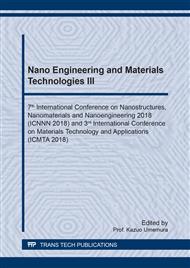p.77
p.82
p.91
p.96
p.103
p.109
p.114
p.119
p.125
Prediction of Hardness in Drawn Copper Wire by Effective Strain from Finite Element Simulation
Abstract:
The study developed a hardness-strain reference curve to be used with the finite element simulation for the prediction of the hardness in the drawn copper wire. The hardness values of the deformed copper specimens from tensile tests were analyzed to construct a relationship between hardness and strain. By using an industrial wire drawing machine, a copper wire was drawn by 5 passes to reduce its diameter from 8 to 4.64 mm. All drawing dies used the same configurations which include an area reduction ratio of 20 percent, an approach angle of 7°, and a bearing length of 0.5 times the feeding wire diameter. The finite element simulations of the wire drawing processes were also performed to predict the effective strains in the drawn copper wires. With the use of the developed hardness-strain curve, the hardness of the drawn wires can be estimated. The results show that the difference between the predicted and measured hardness values is about 10 percent lower in the early stage of the wire drawing process, and the difference increases with the number of passes to about 30 percent higher in the later stage of the process.
Info:
Periodical:
Pages:
103-108
Citation:
Online since:
March 2019
Authors:
Keywords:
Price:
Сopyright:
© 2019 Trans Tech Publications Ltd. All Rights Reserved
Share:
Citation:


